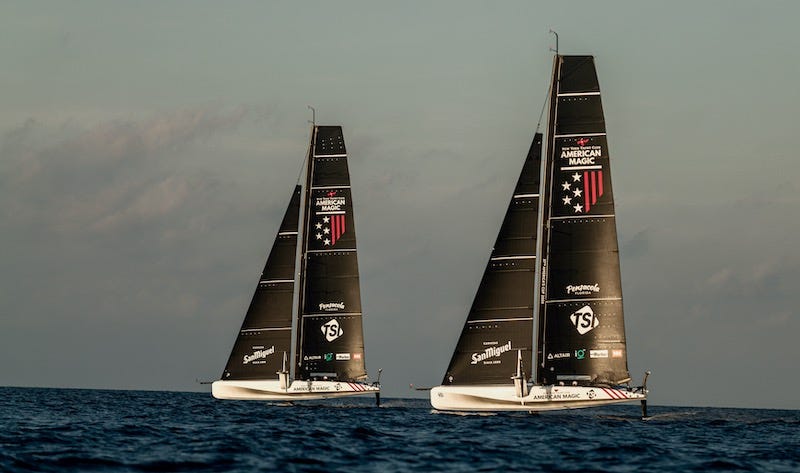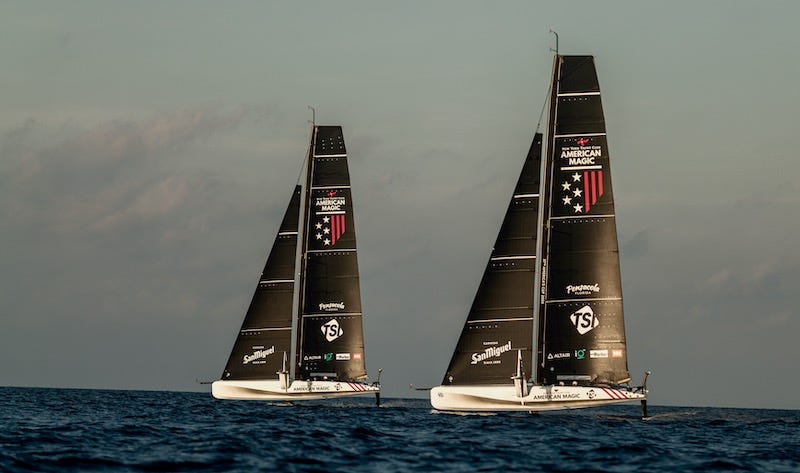Barcelona Notebook: Every day’s a school day…
After the excitement of the racing at last month’s first preliminary regatta of the 37th America’s Cup cycle the five teams based in Barcelona have dived straight back into testing and training
For the America’s Cup teams from New Zealand, Great Britain, USA, Switzerland, and France there have been many long days out on the water recently – both for sailors and for their ever-present support teams who shadow and track the yachts’ every move.
By its very nature America’s Cup training and testing is a highly secretive affair and although the boats are sailing in plain sight it is not always easy to work out the exact focus of the individual teams.
Certainly, with all the teams believed to have begun construction on their next generation AC75s there will have been a general shift away from foil testing or design tool validation – perhaps in favour of development and testing of the boats’ complex on board systems.
Weather matters
The five Barcelona-based syndicates have been making the most of the opportunity to assess the local Mediterranean weather conditions at the Cup venue 12 month’s out from next year’s Match.
Although much has been commented on previously about the potential for strong winds and heinous sea states on the waters off Barcelona, the first week of October has in fact produced as many light wind / flat water days as it has windy / choppy ones.
The couple of days when the breeze was in the sub-10-knot range with super flat water were perfect for the teams to practise their light air take off technique.
Getting an AC40 or an AC75 airborne is all about reaching the critical velocity required to get water flowing over the foils fast enough for them to be able to generate the necessary lift.
For the trimmers that means contorting the sails to generate absolute maximum power while the boat is in displacement mode. But the second the boat breaks free of the water their focus must instantly switch to flattening the sails again to reduce drag as the boat accelerates in its own self-created apparent wind.
Emirates Team New Zealand helmsman Nathan Outteridge described the take off process this way:
“There's a big role division when it comes to trying to get the take-off to happen. Those people trimming the sails at the time are always trying to strive for the most power they can get out of the main and the jib – and the flight controllers are trying to keep the boat as flat as possible.
“Then there's a moment where you think you're at your boat speed for take-off and that's when you squeeze everything on harder and generate more lift from the foils. If you can push it up in the air you're away – but if you're not patient enough and you go too early then the speed starts to drop again.”
This week’s light wind days will also have been useful for the crews to learn more about where precisely the cross-over points are between the huge J1 headsails and the slightly smaller J2s.
Determining when the huge sail area of the J1 is preferable to the smaller but lower drag of the J2 is going to be critical when racing at the lower end of the America’s Cup 6.5 to 21-knot wind range.
Choose your weapon
Given the opportunity to sail at the Match venue a year ahead of the 37th America’s Cup it was no real surprise to see the Defender Emirates Team New Zealand and Swiss challenger Alinghi Red Bull Racing wheel out their previous generation AC75s over recent days.
The hydraulic systems powering the sail controls on both boats are now driven by cyclors, whose bent backs and bobbing heads are just visible over the tops of the cockpit coamings.
There’s a vast gulf of AC75 experience between the battle-hardened Kiwi squad and the youthful and talented group of AC75 newcomers that make up the Swiss sailing team.
Unsurprising then, the New Zealanders barely put a foot wrong in the blustery winds on Wednesday October 4 – while the Swiss looked to constantly be struggling to get their AC75 under control.
In winds touching 20 knots the Kiwis were an impressive sight both upwind and down ripping around the America’s Cup race area off the iconic W Hotel at speeds over 50 knots that left the recon team and their own chase boats struggling valiantly to keep up.
Despite the fruity conditions the teams’ tacks and gybes were crisp and accurate and the two helmsmen, Peter Burling and Nathan Outteridge seemed comfortably able to bend the powerful boat to their collective will.
For the Swiss, however, the day did not go as well after a spectacular high speed nosedive during a bear away manoeuvre tore the clew of their J3 headsail
For sure, the Alinghi sailors are on a steep and treacherous learning curve right now but no one should write them off at this early stage. There is a ton of talent and national pride in that Swiss line-up and they are sailing aboard a heavily modified boat that already had a reputation as being difficult to tame.
Effectively Swiss sailors are running with rocks in their pockets right now but if their new boat turns out to be on the pace then the learnings in the old boat could well make them a potent force in the Challenger Selection Series.
Meanwhile, the highly-disciplined NYYC American Magic outfit continues to impress with a focus on two-boat testing of their various foil and sail designs aboard their pair of AC40s.
It doesn’t take more than a glance at the team to recognise that this is very much American Magic 2.0. There is a very different feel to the team to the one that was eliminated first from the last America’s Cup cycle.
Much of this can be attributed to a new layer of C-level management, as well as the impact made by the team’s new highly-experienced coach, Tom Burnham, who looks to be flourishing in his new role. Out on the water Tuesday this week it was hard not to be impressed by the sailors’ relentless work rate and precision sailing as they painstakingly trialled a new foil against a modified existing foil.
Given that the two boats only arrived back at the dock at sunset there will doubtless have been several terabytes of new data gathered that day for the designers to pore over. For his part, though, Burnham was giving away few specifics about what had been learned.
“Sometimes we can we can get different conclusions about which foils like which boat speed,” he said after sailing. “Some foils like to go faster than others and some like to go higher and slower, so we're just trying to figure out the sweet spot of each of the different foils and try and figure out the balance of which one will go best around the whole race track.
“Then that's part of what we're looking for in the manoeuvres as well – not just to get the straight-line performance but also the manoeuvring performance of these foils.
So it's an exciting time when you're testing our own foils and get to do all these types of tests with two boats.
There was a disappointing end to the week for the British INEOS Britannia crew who had just got their LEQ12 T6 test boat back on the water after a structural issue with the starboard foil on their T6 test boat discovered during training on September 26 saw a T6 out of action for more than a week. This forced the team switch over to their AC40 for some (admittedly much-needed) training time to hone their boat handling skills.
Ben Ainslie’s team finally got T6 out sailing again on Thursday – albeit with the two original matched foils that the boat was launched with a year ago – but disaster struck just the following day when a catastrophic failure to the rudder assembly while tow testing at 30 knots resulted in vicious 180 degree spin out.
Happily, nobody on board was injured, but the British LEQ12 is now back in the shed for the next two weeks for an assessment of what caused the failure and the subsequent repair work.
How much this loss of precious testing time will impact the campaign is hard to accurately determine but for now the team are putting on another brave face and plan to return to AC40 sailing next week.
Finally, France’s Orient Express Racing Team had some mopping up to do aboard their one-design AC40 on Thursday after a high speed nosedive wipeout saw them destroy their headsail. Once again all aboard were uninjured and the French boat was ready for action the following day.
So, all-in-all, an action packed few days here in Barcelona.
Thanks for reading and standby for more Barcelona Notebook updates soon.
JC








